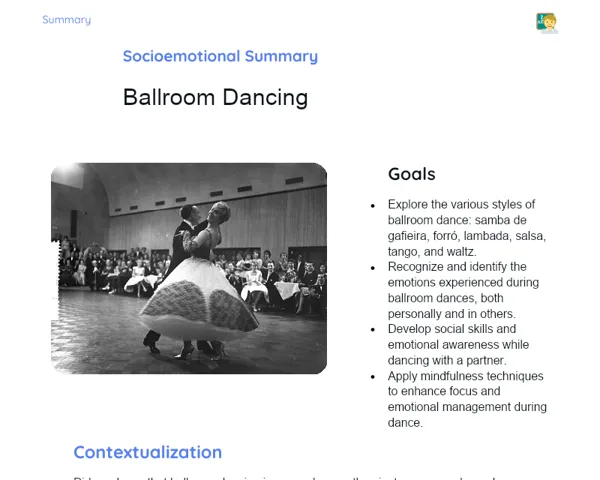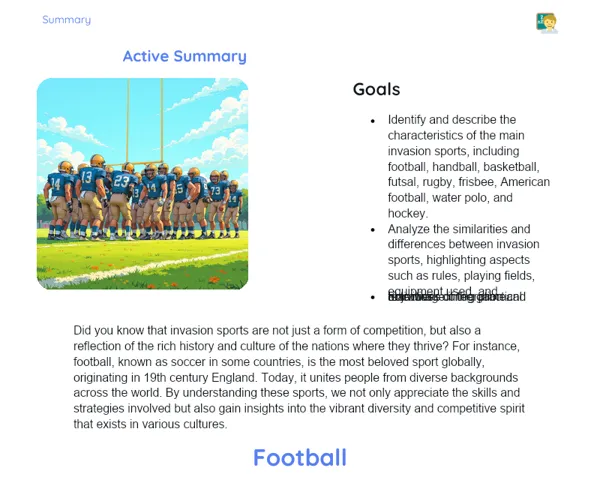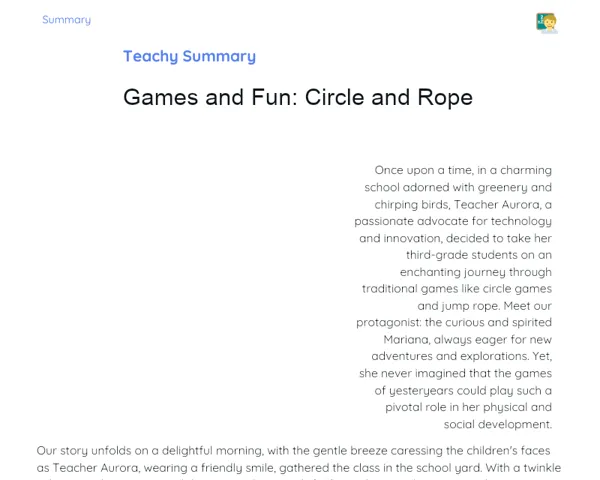Summary Tradisional | Dance as Historical Heritage
Contextualization
Dance is one of the most ancient forms of human expression, recognized since prehistoric times to celebrate significant events, tell stories, perform religious rituals, and even as a mode of communication. It exists in almost every culture across the globe, and each dance style embodies a rich part of the history and traditions of its people, making it a vital aspect of our historical and cultural heritage. Dance serves as a bridge to preserve and pass down cultural values across generations, helping to keep alive the distinct identities of various communities.
Beyond its cultural significance, dance also plays a vital role as a form of physical activity. It enhances motor coordination, flexibility, and physical stamina, while also boosting mental health by improving mood and self-esteem. Various dance forms like Kathak, Bharatnatyam, and Bollywood dance not only reflect the unique culture and heritage of India but also promote health and wellness among practitioners. Hence, studying dance as a historical heritage is about recognizing its importance for both cultural preservation and the encouragement of a healthy lifestyle.
To Remember!
History of Dance
Dance is one of the earliest forms of expressing human emotions. Since prehistoric times, communities have used dance to mark significant occasions, conduct rituals, narrate tales, and communicate feelings. Through dance, ancient civilizations were able to convey their emotions, beliefs, and customs collectively, thereby strengthening community bonds.
As time passed, dance evolved and branched into various styles, each reflecting the unique cultural traits of its region. For instance, during the medieval period, dance was central to celebrations in royal courts across Europe. The Renaissance saw dance attaining an even more prestigious place, being formalized and examined as a refined art form.
In modern times, dance continues to be a significant aspect of society, recognized as a form of artistic and cultural expression. Many traditional dance styles are preserved and still practiced today, ensuring the narratives and customs of diverse communities endure. Additionally, new dance styles continue to emerge, reflecting cultural shifts and innovations.
-
Dance is a form of human expression used since ancient times.
-
It has evolved into diverse styles over the years.
-
It remains an essential part of contemporary societies.
Dance Styles and Their Origins
There is an incredible variety of dance styles, each with its unique features and historical backgrounds. For instance, Bharatanatyam originates from Tamil Nadu and is celebrated for its intricate footwork and expressive gestures. Kathak, from North India, is characterized by rapid spins and eloquent storytelling incorporating facial expressions.
Samba, which hails from Brazil, is an energetic and festive dance reflecting Brazilian culture and its African influences. Another notable example is Kuchipudi, a classical Indian dance form that emphasizes storytelling and dramatic expression through dance.
Each of these dance styles captures the essence of its culture and history while contributing to the rich tapestry of global cultural diversity. Exploring these styles allows for a deeper appreciation of the traditions and values embedded in various communities around the world.
-
Countless dance styles each have unique traits and origins.
-
Notable examples include Bharatanatyam, Kathak, Kuchipudi, and Samba.
-
Each style is a reflection of its respective culture and contributes to cultural diversity.
Dance as a Physical Activity
Dance stands out as a robust form of physical activity, offering wide-ranging benefits for both body and mind. It sharpens motor coordination, allowing dancers to fine-tune their body awareness and movement control. Dance also improves flexibility since many styles incorporate expansive movements and stretching.
Moreover, physical endurance is enhanced through dance, as various styles involve dynamic and repetitive movements which stimulate cardiovascular health. Regular dance practice leads to notable improvements in stamina and muscle strength.
In addition to these physical advantages, dance significantly benefits mental health. It can elevate one's mood, alleviate stress, and boost self-esteem. Engaging with others in dance classes and performances further enriches emotional well-being, fostering a strong sense of community and belonging.
-
Dancing enhances motor coordination and flexibility.
-
It builds physical endurance and cardiovascular fitness.
-
It offers mental health benefits such as improved mood and reduced stress.
Dance and Cultural Heritage
Dance is often recognized as an intangible cultural heritage, serving to preserve and share traditions and stories from generation to generation. UNESCO has acknowledged various dance forms as intangible cultural heritages, underscoring their significance in maintaining the cultural identity of communities. For instance, Kathakali from Kerala and Garba from Gujarat are celebrated for their rich narratives and cultural values.
These dance forms transcend mere movements; they encapsulate profound meanings and cultural values passed down through generations. Safeguarding these dances is crucial to ensure that a community's heritage remains vibrant and relevant.
By studying and engaging in these dances, individuals not only explore the history and culture of others but also cultivate a deeper respect and appreciation for cultural diversity. Thus, dance plays an essential role in fostering mutual understanding and harmonious coexistence among various communities.
-
Dance represents an intangible cultural heritage that transmits traditions and stories.
-
UNESCO-recognized examples include Kathakali and Garba.
-
Exploring and practicing these dances fosters respect for cultural diversity.
Key Terms
-
Dance: A form of human expression used to celebrate, communicate, and perform rituals.
-
Historical Heritage: A set of cultural assets that preserve the history and identity of a people.
-
Culture: A collection of customs, beliefs, and artistic expressions of a community.
-
Physical Activity: Any bodily movement that results in energy expenditure.
-
Cultural Expression: Forms through which a culture manifests, such as dance, music, and art.
-
Motor Coordination: The ability to perform bodily movements in a controlled and precise manner.
-
Flexibility: The ability to move the joints with maximum range.
-
Physical Endurance: The ability to sustain physical effort over prolonged periods.
-
UNESCO: The United Nations Educational, Scientific and Cultural Organization, which recognizes intangible cultural heritages.
-
Mental Health: A state of emotional and psychological well-being.
-
Traditions: Customs and practices transmitted from generation to generation.
-
Cultural Histories: Narratives that compose the identity and memory of a community.
Important Conclusions
Dance, as one of the oldest forms of human expression, plays an essential role in cultural preservation and in promoting a healthy lifestyle. Dance forms like Bharatanatyam, Kathak, and Garba not only reflect the unique cultural backgrounds of their practitioners but also contribute to the broader spectrum of global cultural richness. Dance allows for traditions and narratives to be passed on through generations, thereby reinforcing community identity and unity.
In addition to its cultural value, dance is a remarkable form of physical activity that enhances motor coordination, flexibility, and endurance. It also yields substantial mental health benefits, reducing stress and boosting self-esteem. Regular engagement in dance fosters community spirit and belongingness, enriching the social lives of participants.
Exploring dance as historical heritage is essential for understanding the significance of preserving and valuing diverse cultural expressions. This knowledge broadens our awareness and appreciation for cultural diversity, facilitating peaceful coexistence among various communities. Encouraging students to delve deeper into this subject fosters a generation that is more culturally aware and appreciative of the vast riches surrounding them.
Study Tips
-
Watch videos and documentaries about various dance styles to better visualize and grasp their characteristics and origins.
-
Read books and articles about the history of dance and its cultural influences to deepen your theoretical understanding.
-
Participate in dance classes or workshops to experience the physical and mental benefits of this inspiring activity.



